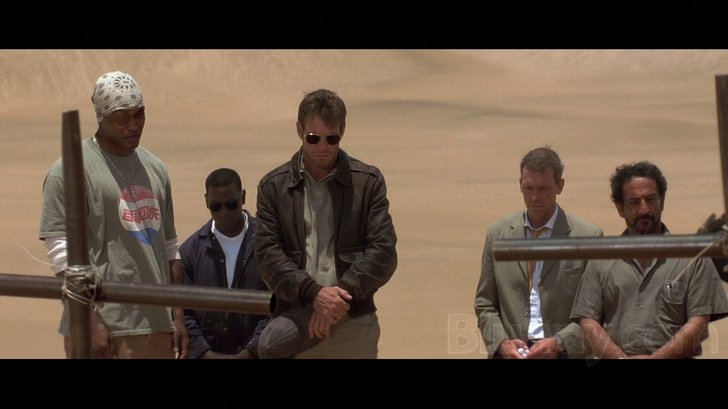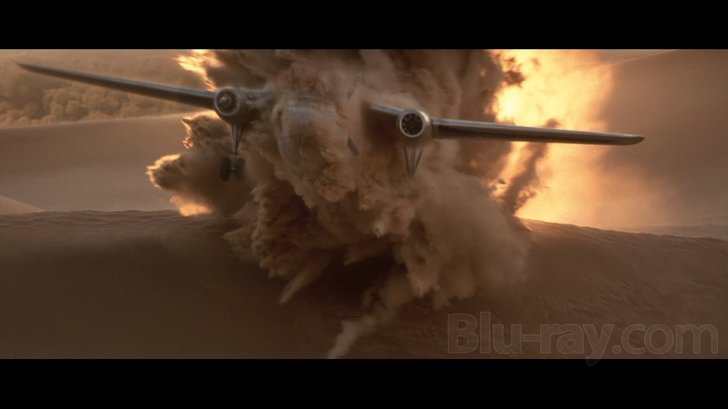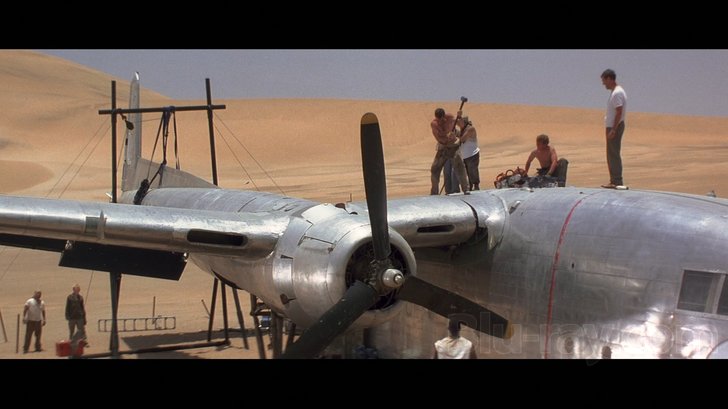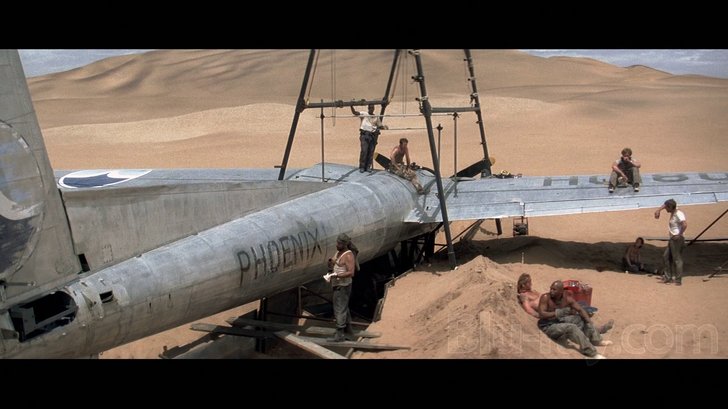Flight of the Phoenix Blu-ray Movie
HomeFlight of the Phoenix Blu-ray Movie 
20th Century Fox | 2004 | 113 min | Rated PG-13 | Dec 05, 2006
Movie rating
6.4 | / 10 |
Blu-ray rating
| Users | 4.1 | |
| Reviewer | 3.5 | |
| Overall | 3.8 |
Overview
Flight of the Phoenix (2004)
A group of air crash survivors are stranded in the Mongolian desert with no chance of rescue. Facing a brutal environment, dwindling resources, and an attack by desert smugglers, they realize their only hope is doing the impossible... building a new plane from the wreckage of the old one.
Starring: Dennis Quaid, Tyrese Gibson, Giovanni Ribisi, Miranda Otto, Tony CurranDirector: John Moore (V)
| Action | Uncertain |
| Thriller | Uncertain |
| Adventure | Uncertain |
| Drama | Uncertain |
Specifications
Video
Video codec: MPEG-2
Video resolution: 1080p
Aspect ratio: 2.35:1
Original aspect ratio: 2.39:1
Audio
English: DTS-HD Master Audio 5.1 (48kHz, 24-bit)
French: Dolby Digital 5.1 (448 kbps)
Spanish: Dolby Digital 5.1 (448 kbps)
Subtitles
English SDH, Spanish
Discs
25GB Blu-ray Disc
Single disc (1 BD)
Playback
Region A (locked)
Review
Rating summary
| Movie | 3.0 | |
| Video | 3.5 | |
| Audio | 4.5 | |
| Extras | 2.5 | |
| Overall | 3.5 |
Flight of the Phoenix Blu-ray Movie Review
An A/V Oldie but Goodie
Reviewed by Michael Reuben February 25, 2012The Blu-ray format has experienced its share of ups and downs, and every major studio has made missteps, even the usually reliable Sony. But looking back from the present vantage, with hardware compatibility largely a non-issue, it's remarkable what results the format could achieve even in its earliest incarnation, given the right material. Flight of the Phoenix was part of the initial wave of titles released by Fox Home Video on Blu-ray during the format's debut year, and Fox was so new on the learning curve that it was still using DVD's relatively primitive MPEG2 compression, instead of the newly introduced (and superior) AVC encoding that has since become the de facto industry standard. Dual-layer BD-50s were still a rarity, because Blu-ray production capacity remained low, with new factories under construction, and BD-25s could be pressed more quickly with a lower error rate. And post houses and telecine technicians had only just started to re-learn their craft, because hi-def media didn't require—and wouldn't let them get away with—the bag of tricks they'd used to disguise DVD's lack of resolution. (The whole issue would quickly become more complicated as the marketing tug-of-war intensified between originalists and grainophobes.) Flight of the Phoenix got skipped by the review process on release; so now it provides an opportunity to reflect on how an early Blu-ray holds up by today's standards. In this instance, the verdict is quite favorable. Right from the start, excellent results could be obtained from a recent film with a first-rate, digitally engineered soundtrack and a picture that had been finished on a digital intermediate, ensuring a pristine archival source from which to derive a Blu-ray image.

As with many classic adventure tales, Flight of the Phoenix has a simple story. The company funding an exploratory oil rig in Mongolia's Gobi Desert decides to shut it down based on the cost-benefit analysis of an on-site "suit" named Ian (a pre-House Hugh Laurie). This doesn't sit well with the rig's supervisor, Kelly Johnson (Miranda Otto, fresh off Lord of the Rings), but she has no say in the matter. A cargo plane arrives to remove all personnel and portable gear; the pilot is Frank Towns (Dennis Quaid), and the co-pilot is A.J. (Tyrese Gibson). Whatever drama may be transpiring among the people they've come to haul, these two just want to load up and get out of there. At the last minute they're joined by a mystery passenger named Elliott (Giovanni Ribisi), whose presence at the rig is said to be "a long story". The plane encounters a massive, violent sandstorm, and it's carrying too much weight to fly over or around it. (A question never answered is how much extra weight the plane is carrying and whether Elliott, the unexpected traveler, is sufficient to account for the difference.) In a lengthy, harrowing and detailed sequence that is a triumphant meld of practical and digital effects, the sandstorm methodically rips the plane to pieces while Towns struggles to land it on the desert surface. Not everyone survives the experience, but those who do are stranded with no communications, limited food and water and no realistic prospect of rescue. Their only hope is to build a new plane out of the wreckage of the old one, a task they're able to undertake because, as it turns out, Elliott designs airplanes for a living. (Why he's out there in the desert going walkabout is never explained.) Their biggest challenge, as is usually the case with any group, is overcoming internal differences, some of them predictable and some of them not. Flight of the Phoenix has a lot going for it. The threat doesn't require complex setups or backstories to be compelling; conflicts among the survivors are built into the situation; the cast is uniformly capable; and director John Moore's insistence on shooting in the cinematically gorgeous and expansive desert land of Namibia provides scale to the survivors' predicament and an authentic sense of their isolation. The film's greatest weakness is that it peaks too early. After the white-knuckle intensity of the early crash sequence, there's still about ninety minutes to go, and if you're going to key up an audience's energy levels that high at the beginning, you'd better have a few more tricks up your sleeve. Unfortunately, neither Moore nor his screenwriters, Scott Frank and Edward Burns (yes, that Edward Burns), have anything even remotely close, although it isn't for lack of trying. They give us additional sandstorms, a fuel explosion, constant battles among the survivors, an eleventh-hour surprise regarding the "Phoenix" (as they christen their rebuilt craft) and the ever-present threat from a nomadic band of merciless Mongolian mercenaries, but none of it returns the film to the energy spike it achieved in its first eighteen minutes. Even the sight of a dozens of armed men on horseback chasing after the newly revved-up Phoenix racing toward the drop-off into a bottomless gorge can't generate enough excitement to re-galvanize the story. After the initial crash, it really is all downhill.
Flight of the Phoenix Blu-ray Movie, Video Quality 

Even though Fox's 1080p, MPEG2-encoded Blu-ray may not represent the ultimate in technology, it still looks remarkably good. Part of this is due to the quality of the source material. As director Moore explains in his commentary, he and his director of photography, Brendan Galvin, made a conscious effort to use wide lenses that would make the most of the exotic locale to which they'd forced the cast and crew to undertake such an arduous expedition. An advantage of such lenses is to provide sharper focus, and thus better detail, in larger expanses of the frame. The Blu-ray reflects this improvement in detail in its feel for the minutia of desert sands, the nuts and bolts of the old plane as it's disassembled and the new one being built, and the wear and tear on the survivors and their faces and clothing as their days in the desert add up. Black levels are quite good, a tricky balance as Moore notes in the commentary, since the real desert at night would be dark enough that the survivors couldn't see in front of them (an actual plot point in the film), but the photography has to allow the viewer to see the action. Daytime scenes are exceptionally bright in desert daylight, but not so much that contrast washes out detail. Colors are as vibrant as they can reasonably be in an environment where the desert sun overpowers everything. Several user reviews of this title have noted the presence of grain in the image, but presumably by now most Blu-ray fans have caught up with the notion that grain is an inherent characteristic of film. The question is whether the grain patterns have been properly handled in the transfer to Blu-ray, and in Flight of the Phoenix that appears to be the case. Neither improperly reduced nor artificially frozen into place ("hanging grain"), the film's grain appears natural and will not even be noticed in most shots. In general, films finished on a digital intermediate, as Flight was, seem to emerge without damage to their grain structure, presumably because the colorists who work on DIs have to think in terms of large-format projection. If there is any drawback to Flight's image from the use of MPEG2, it is the occasional presence of low-grade video noise, noticeable chiefly in scenes of intermediate brightness. (Extremely dark or light scenes seem to hide it.) If you've ever seen a side-by-side demonstration of the AVC codec with an uncompressed source, you know that AVC's ability to compress images faithfully without adding noise or distortion is truly remarkable. MPEG2 cannot claim the same distinction, and every so often on Flight, its limitations show through. But it's a minor problem, and certainly no reason to pass up the disc.
Flight of the Phoenix Blu-ray Movie, Audio Quality 

Director Moore says in his commentary that Flight will reward your investment in a home theater system, and he isn't kidding. The extended crash sequence a quarter hour into the film is a masterpiece of sonic engineering, and it remains demo material to this day, beautifully delivered (along with the rest of the film's soundtrack) in DTS-HD MA 5.1. In addition to its room-rattling lower end, the intricately layered mix surrounds the listener with a frightful cascade of snapping cables, ripping metal, the impact of dismembered engine parts striking the fuselage and dozens of other sickening sounds that no flier wants to hear, until you're sure it can't get worse—and then the plane strikes a rocky encroachment from a neighboring mountain range and you hear every sound as the rear gets torn open and contents are sucked out and fall to the ground. Like the rest of the film, the remainder of the 5.1 track is something of a letdown after that intense experience, but the mix continues to be active with plenty of atmosphere and interesting rear channel effects throughout. The Phoenix even makes one last "flight" through the rear channels at the end of the credits. Dialogue is clear and well-rendered, and the old-fashioned adventure-movie score by Marco Beltrami sounds appropriately full and dashing.
Flight of the Phoenix Blu-ray Movie, Special Features and Extras 

I do not have the DVD for comparison, but reports indicate that it contains extras not included on the Blu-ray, including a documentary and deleted scenes.
- Commentary with Director John Moore, Producers John Davis and Wyck Moore, and Production Designer Patrick Lumb: Moore does most of the talking, and his soothing Irish lilt contrasts starkly with the harsh conditions he describes as he details the rigors of the shoot in the Namibian desert where Flight was filmed. The studio brass was initially resistant to sending a cast and crew to such a remote location, but they quickly changed their tune when the producers showed them how cheaply the movie could be made in Namibia, even with transport costs. Moore offers special praise to his sound engineers for their work on the sandstorm/crash sequence, for which, Moore says, they literally rewrote the code for the LFE channel of 5.1 sound.
- Trivia Track: I have said on prior occasions that I'm not a fan of "pop-up" trivia tracks, but at least this one has the virtue of reciting facts relevant to the film and its personnel. As a result, though, the pop-ups are less frequent, thereby confirming what I have long suspected, namely, that the "jokey" pop-ups on these tracks are largely filler. Also, if you've already listened to the commentary track, almost everything on the trivia track has already been covered.
- Trailers (HD, 1080p)
- Flight of the Phoenix
- From Hell
- The Omen (2006)
- The Transporter
- X-Men: The Last Stand
Flight of the Phoenix Blu-ray Movie, Overall Score and Recommendation 

Alert readers may wonder why I've made no mention of the 1965 Flight of the Phoenix starring Jimmy Stewart and directed by Robert Aldrich, of which this is a remake. It's been so long since I've seen that film that I can't remember it well enough to provide any meaningful comparison. Besides, Moore's film is a peculiarly contemporary creation, with its emphasis on visual and sonic elements, which is what made it such a likely candidate for the first wave of Fox Blu-rays. The Stewart/Aldrich film was more of a character drama, a point that Moore makes indirectly when he talks about it as almost a stage play. The time for a comparison is when Fox has issued both films on Blu-ray, so that we can look at both of them in presentations of equal quality. Until then, crank up your system and cue up the crash sequence. Recommended.
Similar titles
Similar titles you might also like

The Grey 4K
2011

2012 4K
2009

The Day After Tomorrow
2004

The Perfect Storm
2000

Vertical Limit
2000

Plane
2023

Sanctum 4K
2011

San Andreas 4K
2015

Babylon A.D.
2008

Riddick 4K
2013

The Delta Force 4K
1986

Twister 4K
1996

Centurion
2010

Stealth
2005

The Condemned
2007

Poseidon 4K
Limited Edition
2006

Shooter 4K
2007

The Poseidon Adventure
2005

Killing Season
2013

Kandahar
2023